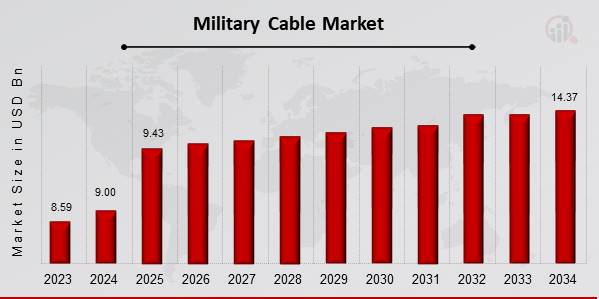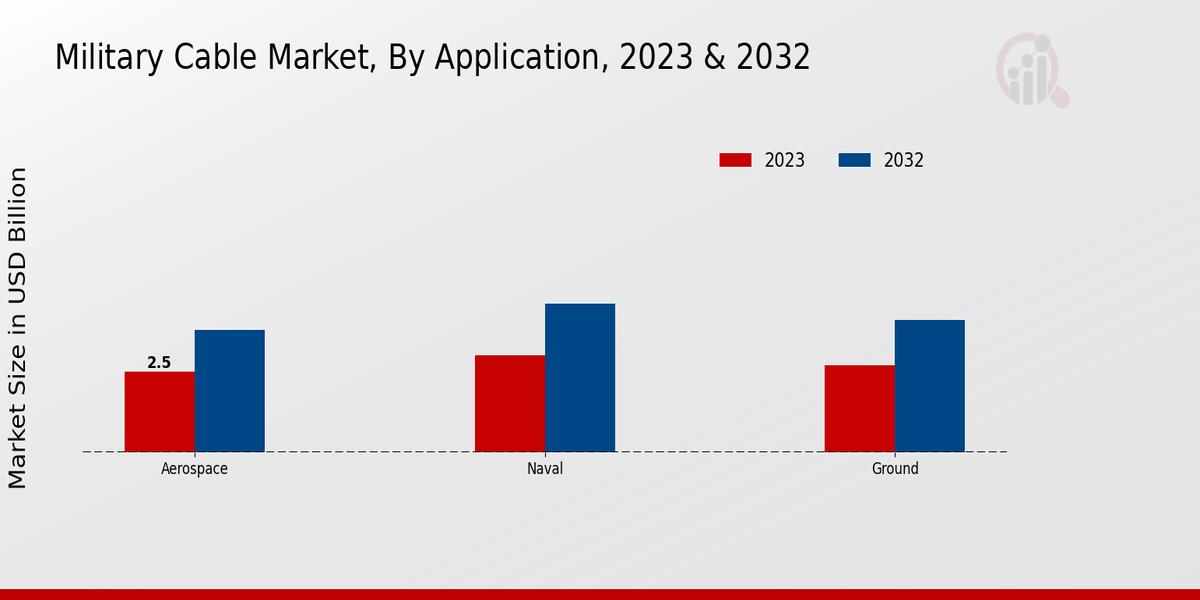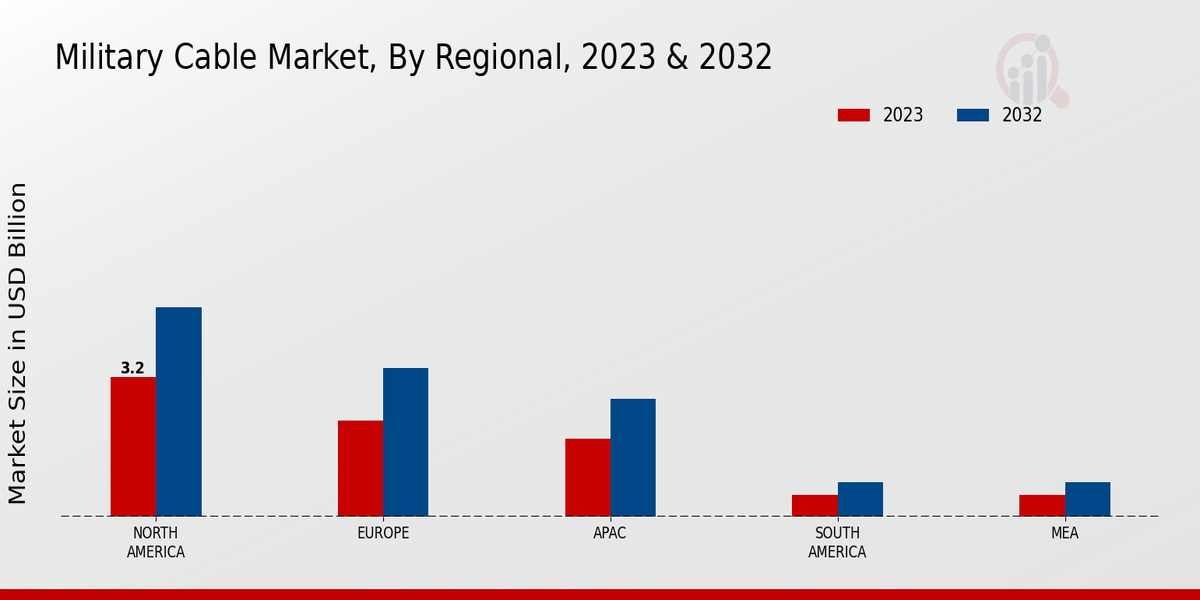Global Military Cable Market Overview
Military Cable Market Size was estimated at 8.59 (USD Billion) in 2024. The Military Cable Market is expected to grow from 9.00 (USD Billion) in 2025 to 14.37 (USD Billion) by 2034. The Military Cable Market CAGR (growth rate) is expected to be around 4.80% during the forecast period (2025 - 2034).

Source: Primary Research, Secondary Research, MRFR Database and Analyst Review
Key Military Cable Market Trends Highlighted
The Military Cable Market is witnessing several important trends driven by increasing defense budgets and the need for advanced technology. Nations are focusing more on modernization and upgrading their military infrastructure, which is leading to a surge in demand for high-performance cables that offer reliability and efficiency.
The push for smart military technologies and the integration of advanced communication systems are key drivers in this market. These developments necessitate cables that can withstand extreme conditions while ensuring seamless data transfer and connectivity.
There are numerous opportunities to be explored in this market, specifically in areas such as the development of environmentally friendly materials and lightweight cables.
The rising demand for unmanned systems and drones in military applications also creates a need for specialized cables that can support these technologies. Additionally, increased collaboration between military and civilian sectors offers a chance to innovate and enhance cable designs tailored for various applications.
As countries continue to invest in next-generation military equipment, manufacturers have the chance to expand their product offerings and enter new markets.
Recent trends include a growing emphasis on cybersecurity, particularly in safeguarding communication networks within military operations. This trend demands cables that not only deliver robust performance but also incorporate features that enhance security.
Similarly, there's a shift towards modular cable systems, which allow for flexibility and scalability in military applications. Overall, the Military Cable Market is evolving rapidly, supported by technological advancements and changing defense strategies across nations, setting the stage for substantial growth and innovation in the coming years.
Military Cable Market Drivers
Increasing Defense Budgets
One of the most significant drivers for the Military Cable Market is the rising defense budgets across various countries. Governments worldwide are recognizing the need to enhance their military capabilities and readiness in response to evolving global threats.
This increase in defense spending is primarily driven by geopolitical tensions, territorial disputes, and the need for modernization of armed forces. Consequently, countries are investing heavily in advanced technologies and infrastructure, thereby leading to a greater demand for military cables used in various applications such as communication, control systems, and weaponry.
As military operations become more sophisticated, the requirement for reliable and high-performance cables that can withstand extreme conditions is paramount.
This trend of bolstering military expenditures is expected to create significant opportunities for the Military Cable Market in the upcoming years as manufacturers strive to meet the soaring demand for specialized cables designed for defense applications.
Additionally, the focus on enhancing the survivability and operational capabilities of military assets will further drive the market, ensuring a sustainable growth trajectory well into the future.
Through strategic partnerships and innovation, industry players are likely to expand their product offerings to cater to the specific needs of the military sector.
Technological Advancements in Military Equipment
Technological advancements play a crucial role in shaping the Military Cable Market. With the rapid pace of innovation in military equipment, there is an increasing need for high-performance cables that can support advanced systems such as unmanned aerial vehicles (UAVs), communications systems, and sophisticated weapon systems.
These technological developments require cables that not only deliver excellent electrical performance but are also lightweight, durable, and capable of operating in extreme environments.
As military operations become more integrated with cutting-edge technologies, the demand for innovative cable solutions that can meet these rigorous standards is expected to grow significantly. Manufacturers are therefore motivated to invest in research and development to create cables that are better suited for high-tech applications, driving the market further.
Growing Demand for Enhanced Communication Systems
The increasing focus on enhanced communication systems within military operations is another key driver for the Military Cable Market. Modern warfare relies heavily on seamless and secure communication between various units and command centers.
As military strategies evolve, the demand for high-speed, reliable communication networks becomes crucial for operational success. This necessitates the deployment of advanced military cables that can facilitate rapid data transfer and ensure robust connectivity in challenging environments.
As armed forces continue to adopt more complex communication systems, the reliance on sophisticated cable solutions to support these infrastructures will grow, further fueling the demand within the military cable market.
Military Cable Market Segment Insights:
Military Cable Market Application Insights
The Military Cable Market revenue reflects a dynamic landscape, particularly within the Application segment that encompasses Aerospace, Naval, and Ground domains. Focusing on the Aerospace application, this sector held a significant portion of the market with a value of 2.5 USD Billion in 2023, expanding to 3.8 USD Billion by 2032.
This growth is primarily attributed to the increasing investments in advanced military aviation technologies, as well as the ongoing developments within unmanned aerial systems. The Naval application stood as a critical player in this market, demonstrating a valuation of 3.0 USD Billion in 2023, projected to increase to 4.6 USD Billion by 2032.
The importance of this sector was evident as modernization efforts in naval operations and the rise in maritime security needs further bolstered its standing. Lastly, the Ground application is valued at 2.7 USD Billion in 2023 and is expected to rise to 4.1 USD Billion in 2032.
This segment is crucial as it supports a range of military ground vehicles and equipment essential for advancing land-based military capabilities. Notably, the Naval segment currently dominates the Application landscape due to its critical role in ensuring national security and defense capabilities, accounting for a majority holding in the overall market valuation.
The Military Cable Market statistics reflect ongoing trends toward increased defense spending, technological advancements in military equipment, and the need for enhanced infrastructural capabilities across these applications.
These evolving trends create significant opportunities for stakeholders within the industry while also presenting challenges such as stringent regulations and the need for continuous innovation.
Overall, the insights about the Military Cable Market segmentation highlight a sector ripe with growth potential, showcasing the importance of the Aerospace, Naval, and Ground segments in advancing military operations across the globe.

Source: Primary Research, Secondary Research, MRFR Database and Analyst Review
Military Cable Market Cable Type Insights
Coaxial cables are significant in military applications due to their reliability and the ability to transmit data over long distances without much loss. Fiber optic cables dominate the communication sector thanks to their high-speed data transmission capabilities and resistance to electromagnetic interference, making them essential for secure military communications.
Twisted pair cables, while less dominant, still find relevance in certain military applications through their cost-effectiveness and ease of deployment. The market is driven by increasing defense budgets and the demand for advanced communication networks, with the Military Cable Market statistics underscoring the growth potential of these cable types in modern military infrastructure and operations.
Challenges such as technological advancements and the need for enhanced durability are balanced by opportunities to integrate advanced materials and technologies into military cable systems, paving the way for market growth.
Military Cable Market Material Insights
The market is characterized by a growing emphasis on durable and reliable materials, with the demand for advanced military cables being driven by an increase in defense expenditures and modernization of military infrastructure.
Among the materials, Copper is often utilized for its excellent conductivity and reliability, making it highly significant despite the rise in alternative materials. Aluminum, known for its lightweight properties, is also important as it reduces overall system weight while maintaining strength, thus enhancing efficiency in military applications.
Fiber optics have gained traction due to the growing need for high-speed data transmission in military communication systems, highlighting their dominant position in modern warfare technology.
The Military Cable Market segmentation showcases how these materials cater to specific operational needs, illustrating their essential roles in enhancing the effectiveness of military systems and operations across the globe.
Military Cable Market End Use Insights
Within this landscape, the Defense sector plays a pivotal role, as it typically constitutes a significant portion of the market due to its essential need for reliable and advanced communication systems in military operations.
The Civilian end-use segment also shows notable growth potential, driven by increasing government investments and initiatives in secure communication technologies. Furthermore, the Commercial segment is gaining traction, reflecting the broader adoption of military-grade cables in defense contracting and industrial applications.
As a result, Military Cable Market statistics reveal that while the Defense sector may dominate in size, Civilian and Commercial applications present valuable opportunities for innovation and expansion.
Factors such as advancements in technology, rising geopolitical tensions, and the need for enhanced security are key growth drivers for the Military Cable Market, while challenges like stringent regulations and budget constraints remain critical considerations for stakeholders in the market growth.
Military Cable Market Regional Insights
The Military Cable Market exhibits diverse regional dynamics, with North America dominating the market, valued at 3.2 USD Billion in 2023 and projected to reach 4.8 USD Billion by 2032, making it a significant contributor to the overall market revenue.
Europe followed with a valuation of 2.2 USD Billion in 2023, expected to grow to 3.4 USD Billion, highlighting its importance in military applications and defense technologies. The APAC region was also notable, with a valuation of 1.8 USD Billion in 2023 and anticipated growth to 2.7 USD Billion, reflecting increasing military expenditures and modernization efforts.
South America and MEA both held the smallest shares, valued at 0.5 USD Billion in 2023 each, expected to rise to 0.8 USD Billion by 2032, indicating emerging opportunities as these regions enhance their defense strategies.
Overall, the Military Cable Market segmentation reveals a clear hierarchy in market size and growth potential, with North America and Europe leading the growth trajectory in response to advanced military requirements and technological advancements.

Source: Primary Research, Secondary Research, MRFR Database and Analyst Review
Military Cable Market Key Players and Competitive Insights:
The Military Cable Market is essential for the defense sector, as it supports various applications ranging from communication systems to power transmission within military frameworks. The competitive landscape of this market is characterized by an array of players, each striving to innovate and expand their range of offers.
As the demand for military cables escalates due to advancements in technology and rising military expenditure globally, companies are focusing on enhancing their product portfolios and establishing strategic partnerships.
The shift towards more sophisticated military operations necessitates the development of high-performance cable solutions that can withstand extreme conditions, thereby intensifying competition among market participants.
This dynamic environment drives companies to invest in research and development, ensuring they stay relevant in a market that is increasingly responsive to technological change and varying customer needs.
Hawke International has established a strong foothold in the Military Cable Market, leveraging its extensive experience in providing tailored solutions for military applications. The company is renowned for its innovative designs that prioritize durability and reliability, aligning with the critical requirements of military operations.
One of the significant strengths of Hawke International is its commitment to quality, which has earned it a solid reputation amongst military organizations seeking cables that perform optimally under extreme conditions.
Additionally, Hawke International's strategic focus on collaboration with defense agencies and manufacturers allows it to stay ahead of emerging trends and customer demands. Their robust distribution network also enhances their market presence, ensuring that clients have access to their advanced cable solutions wherever they are needed.
Curtis Wright is another key player competing in the Military Cable Market, recognized for its comprehensive range of products tailored for defense applications.
The company offers an impressive portfolio that includes various cable types designed to meet stringent military specifications. Curtis Wright’s strength lies in its emphasis on technological innovation, which enables it to provide high-reliability solutions that cater to the evolving needs of military programs.
The company's research and development initiatives have positioned it as an industry leader, enabling it to develop cables that not only meet but often exceed existing performance standards.
Additionally, Curtis Wright benefits from a well-established reputation within the defense sector for delivering quality and performance, making it a trusted supplier for military clients worldwide. Its continuous investment in modern manufacturing processes and commitment to sustainability further enhance its competitive advantage in the market.
Key Companies in the Military Cable Market Include:
Military Cable Market Developments
The Military Cable Market has seen significant activity recently, with key players such as Prysmian Group and Amphenol focusing on technological advancements to strengthen their positions. Curtis Wright has reportedly secured new contracts with military organizations, enhancing its portfolio in defense applications.
Southwire Company has introduced innovative cable solutions designed to meet the rising demands of military-grade specifications. In terms of mergers and acquisitions, Raychem has been in talks with General Cable for a potential acquisition aimed at expanding its capabilities in the military sector, while TE Connectivity is actively seeking partnerships that would boost its market share in defense-related projects.
Additionally, Nexans has expanded its operations in North America to cater to the growing demand for military cables, and LS Cable & System is focusing on sustainable practices to enhance its appeal in the green technology space.
Overall, as military budgets increase globally, the market performance is set to grow, indicating a competitive landscape among these major companies as they innovate and adapt to shifting defense needs.
Military Cable Market Segmentation Insights
-
Military Cable Market Application Outlook
-
Military Cable Market Cable Type Outlook
-
Military Cable Market Material Outlook
-
Military Cable Market End Use Outlook
-
Defense
-
Civilian
-
Commercial
-
Military Cable Market Regional Outlook
-
North America
-
Europe
-
South America
-
Asia Pacific
-
Middle East and Africa
| Report Attribute/Metric |
Details |
| Market Size 2024 |
9.00(USD Billion) |
| Market Size 2025 |
9.43(USD Billion) |
| Market Size 2034 |
14.37(USD Billion) |
| Compound Annual Growth Rate (CAGR) |
4.80% (2025 - 2034) |
| Report Coverage |
Revenue Forecast, Competitive Landscape, Growth Factors, and Trends |
| Base Year |
2024 |
| Market Forecast Period |
2025 - 2034 |
| Historical Data |
2021 - 2024 |
| Market Forecast Units |
USD Billion |
| Key Companies Profiled |
Hawke International, Curtis Wright, Raychem, General Cable, Southwire Company, Prysmian Group, Amphenol, Cable Manufacturing Company, Belden, LS Cable and System, Acome, Nexans, Marmon Utility, TE Connectivity, Alcatel-Lucent |
| Segments Covered |
Application, Cable Type, Material, End Use, Regional |
| Key Market Opportunities |
Advanced fiber-optic cable solutions, UAV and drone connectivity, Enhanced cybersecurity for military communications, Smart battlefield network integration, and Increased defense budgets globally |
| Key Market Dynamics |
Increasing defense budgets, Technological advancements, Demand for advanced communication systems, Stringent military standards, and Global geopolitical tensions |
| Countries Covered |
North America, Europe, APAC, South America, MEA |
Frequently Asked Questions (FAQ) :
The Military Cable Market is expected to be valued at 14.37 USD billion in 2034.
The expected CAGR for the Military Cable Market from 2025 to 2032 is 4.79%.
North America is projected to have the largest market share, with a value of 4.8 USD billion in 2032.
The Aerospace application segment of the Military Cable Market is expected to reach 3.8 USD billion in 2032.
Key players in the market include Hawke International, Curtis Wright, Raychem, General Cable, and Prysmian Group.
The Naval application segment is expected to be valued at 4.6 USD billion in 2032.
The Ground application segment is projected to reach 4.1 USD billion in 2034.
The European region is anticipated to have a market value of 3.4 USD billion by 2034.
The APAC region is expected to see a market size of 2.7 USD billion in 2034.
Both the South America and MEA regions are expected to have a market value of 0.8 USD billion in 2034.

















